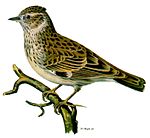Swinley Forest
This articleneeds additional citations forverification.(August 2012) |

Swinley Forestis a large expanse ofCrown Estatewoodland managed byForestry Englandmainly within thecivil parishesofWindleshaminSurreyandWinkfieldandCrowthorneinBerkshire,England.
Coverage[edit]
Situated to the south-west ofWindsor Great Park,the forest stretches fromBracknell,in the north, toBagshot,in the south. It is owned and managed by the Crown Estate and comprises over 2,600 acres (11 km2) of woodland across gently undulating hills. Although now mostly a modern plantation ofScots Pines,the area was once part ofWindsor Forest.Swinley Forest includesCrowthorne WoodsaroundCaesar's Campbetween theNine Mile Rideand Crowthorne;Swinley ParkbetweenForest Parkand theB3017;Bagshot Heathjust west of Bagshot; andSwinley Woodsaround Kings Ride between the B3017 andSouth Ascot.Much of the woods cover what used to be moorland as indicated by the names of some of the hills, such asBroadmoor,Owlsmoor,Wishmoor, Gormoor, Whitmoor and Englemoor (nowEnglemere).
History[edit]
Swinley Parkonce surroundedSwinley Lodgewhere the King kept the Royal Staghounds inGeorgian times.It was at the centre ofSwinley Walke,one of the sub-divisions of Windsor Forest.
In the 18th centuryDaniel Defoe- writing in the fashion of the time of regarding uncultivated land as wild and forbidding - described Bagshot Heath as
"a vast tract of land [...] which is not only poor, but even quite steril [sic], given up to barrenness, horrid and frightful to look on [...] much of it is a sandy desert [...] This sand indeed is checked by the heath, or heather, which grows in it [...] but the ground is otherwise so poor and barren that the product of it feeds no creatures, but some very small sheep, who feed chiefly on the said heather [...] nor are there any villages, worth mentioning, and but few houses or people for many miles far and wide ".[1]
There are a number of late 18th centuryredoubtsscattered throughout the forest. These defensive earth fortifications were built here not as working defences but as training grounds to carry out military exercises in the buildup to theNapoleonic Wars.
In May 2011 forest fires broke out throughout the forest; the cause is believed to be a mixture of the unseasonably dry conditions and arson. Although the fires were stated at the time by theRoyal Berkshire Fire and Rescue Serviceto have been the most extensive fires ever tackled by the service, the extent of the damage to the forest was relatively limited.[citation needed]
Leisure and attractions[edit]
Mountain biking[edit]
The woods provide some of the best mountain biking[2]inSouth-East England,with many off-road 'single-track' trails available as well as plenty of fire roads. Mountain biking no longer requires a permit since the introduction of the three marked trails (Green, Blue and Red) and walking is free. Swinley Woods was originally submitted as the proposed venue for the mountain biking event of the2012 Summer Olympics,[citation needed]however, the distance from the main Olympic Park was considered too great and the heavy forestation along most of the suggested routes would have resulted in poor camera access and views. The event was instead located atHadleigh FarmnearHadleigh,Essex.
Visitor centre[edit]
At Gormoor on theNine Mile Ride,on the northern edge ofCrowthorne Woods,isThe Look Out Discovery Centre,operated byBracknell ForestBorough Council. This is a hands-on science exhibition and nature discovery centre, which also acts as a visitor centre for the forest, providing maps, car parking and bike hire. Most of the self-guided walks and bike trails start and end at the centre.
Caesar's Camp[edit]

Adjoining theLook Outis anIron Agehill fortknown asCaesar's Camp.It is the only one in East Berkshire. It has not been excavated but Iron Age coins have been found there. The name only dates from the 18th century. Caesar's Camp appears to have fallen under the rule ofCunobelin,king of theCatuvellaunitribe in the first century AD from a coin discovered in the interior. Soon after, theRomansinvaded England; after this time, there is no evidence that Caesar's Camp continued to exist as an inhabited community. A road from its south entrance was later built, connecting it to theDevil's Highway (Roman Britain).There is a small Roman settlement about halfway along this road, known as Wickham Bushes, which has yielded pottery and other Roman artifacts.
Aredoubtroughly 40 m across in the fort is thought to be part of a defence line built in 1792 in preparation for the Napoleonic Wars.
Go Ape[edit]
In 2007, aGo Apefacility was opened to the public, featuring a series of tree-top rope bridges and climbs.
Protection status[edit]

Swinley Park and Brick Pitsis aSite of Special Scientific Interest(SSSI) and has protected areas for the birds that live there. Some parts of Swinley Forest are also covered by theBroadmoor to Bagshot Woods and HeathsSSI, one of the largest SSIs in Berkshire. As well as the extensive commercial conifer plantations and mixed woodland the nationally rarelowland heathpresent means Swinley Forest forms part of theThames Basin Heaths,[3]a designatedSpecial Protection Area(SPA), due to the rare ground nesting birds includingwood lark,Dartford warblerandEuropean nightjarwhich nest in open parts of the forest. The area also includes some marshy areas where reptiles andmarshlandplants such ascotton grassare common.
References[edit]
- ^W. G. Hoskins (1977).The Making of the English Landscape.Book Club Associates. p. 140.
- ^"Mountain Bikin UK: Trail of the Year: Swinley Forest, Berkshire"(PDF).Gorrick.Retrieved27 November2012.
- ^"RSPB Thames Basin Heaths"(PDF).Rspb.org.uk.Retrieved27 November2012.

